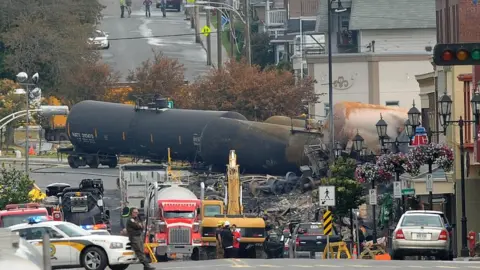Ohio train: Americans blind to toxic dangers rolling through towns
 EPA Handout/Getty Images
EPA Handout/Getty ImagesEvery day, trains laden with potentially harmful materials, like the one that derailed in East Palestine this month, rumble through American towns and cities. Often, residents are unaware of the danger.
Environmental experts warn that without stricter regulation from Congress and increased transparency requirements for dangerous materials passing through residential areas, many more towns and cities will be left in the dark and unprepared, as East Palestine was before a 3 February derailment unleashed a toxic onslaught on the town.
"Millions of people deal with it every single day, they probably just don't know it," says David Masur, executive director of PennEnvironment.
"The potential for a catastrophic train derailment and fire or explosions has been high, it's certainly been something experts have warned about for many, many years".
The Federal Railroad Administration (FRA), which regulates the industry, does not provide lists of the rail lines that hazardous materials travel, according to an agency spokesperson.
Railroad companies are loathe to disclose much information about hazardous cargo and routes the material travels, citing security concerns. Local governments can request information from the railroads annually for the purpose of planning their emergency response.
One of the people left in the dark was Ohio's own governor.
Norfolk Southern had not notified officials that vinyl chloride and other hazardous materials would be winding its way along the tracks that ran through East Palestine the day of the disaster, said Ohio Governor Mike DeWine.
"This train apparently was not considered a high-hazardous material train, therefore the railroad was not required to notify anyone here in Ohio about what was in the rail cars coming through our state," Mr DeWine said at a 14 February press conference.
"If this is true … this is absurd, we need to look at this. Congress needs to take a look at how these things are handled."
At a tense town hall on 15 February, East Palestine's residents expressed frustration at the lack of knowledge about the risk that passed through their backyards each day.
"I wouldn't know what to say if anything could have prevented this, because there's never no information about trains that are going through this town," said Wes Durkis, a local maintenance worker. "My whole life, they just come and go, and we don't know."
 Michael Swensen/Getty Images
Michael Swensen/Getty ImagesFreight trains are used to carry materials both innocuous and hazardous over long distances.
An expansive network of Class-1 railroads, which are operated by the major railroad freight companies and one passenger company, wind their way through America's coasts, heartlands and metropolises each day, racking up millions upon millions of miles every year.
Many of them carry potentially flammable or toxic substances, like crude oil or petrochemicals.
About a thousand train derailments occur in the US each year, according to the FRA. Leaks from trains carrying hazardous materials happen rarely. Only nine such incidents occurred in 2022, according to FRA data. The year with the highest number of hazardous material releases, 2020, only saw 20 such incidents.
But accidents do happen, and when they occur, they can devastate a community.
In 2005, a Norfolk Southern train carrying pressurized chlorine gas crashed in Graniteville, South Carolina, sending a toxic plume over the town. Nine people were killed in the crash and thousands had to evacuate.
A year later, the town's residents told The Washington Post they still suffered consequences from the fallout.
In 2012, a train carrying vinyl chloride - the same chemical primarily involved in the East Palestine incident - derailed in Paulsboro, New Jersey. Cars containing the substance derailed off a bridge and released 23,000 gallons of the chemical.
In 2015, a train carrying crude oil derailed and exploded in the state of West Virginia, destroying a house and contaminating the local drinking water.
North American rail tragedies were not limited to the US. In 2013, a train carrying oil derailed and exploded in the Canadian town of Lac-Megantic, Quebec, killing 47 people and forcing 2,000 residents to evacuate.
 Portland Press Herald via Getty Images
Portland Press Herald via Getty ImagesIn many circumstances, local emergency responders were not prepared to deal with a chemical spill or explosion due to a lack of knowledge about the substances passing through their communities, a ProPublica investigation into railroads used to transport oil found. Emergency managers throughout the US told the investigative outlet that they did not receive notifications about dangerous materials traveling by rail.
Given that these freight lines run through major US cities, as well as small towns like East Palestine, millions of Americans are potentially at risk, environmental experts said.
In Pennsylvania alone, 3.9 million people lived within the evacuation zone of trains carrying crude oil, a study conducted by PennEnvironment found in 2015. That included hundreds of thousands of people in the Philadelphia metro region.
Any changes to railroad regulations would require the federal government to act; states and cities do not have much power to regulate the rail industry because it operates across state lines.
After the accident, East Palestine's residents are hyper-aware of the trains that have resumed passage through their town. And they know just as little about what the carriages carry as they did before the disaster, they say.
"The day they lifted the evacuation, there were trains going through in the background carrying the same thing," said Lisa Hamner, a frustrated East Palestine resident whose business sits just meters from the derailment site.
"What's the next town going to be? It's sad."
Bernd Debusmann Jr contributed to this report.
